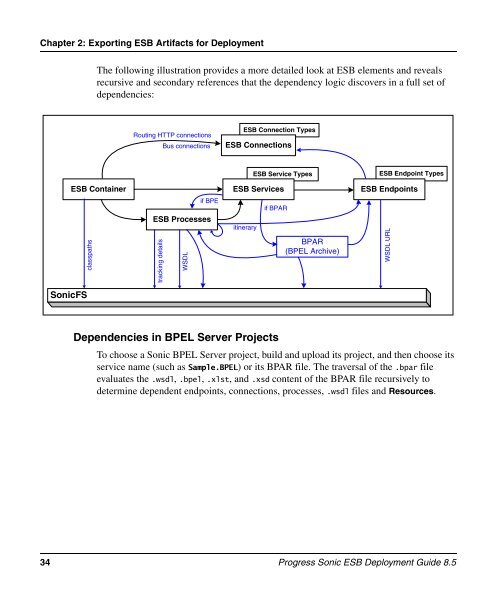esb_deploy - Progress Sonic ESB Deployment Guide 8.5 - Product ...
esb_deploy - Progress Sonic ESB Deployment Guide 8.5 - Product ...
esb_deploy - Progress Sonic ESB Deployment Guide 8.5 - Product ...
Create successful ePaper yourself
Turn your PDF publications into a flip-book with our unique Google optimized e-Paper software.
Chapter 2: Exporting <strong>ESB</strong> Artifacts for <strong>Deployment</strong><br />
<strong>Sonic</strong>FS<br />
classpaths<br />
The following illustration provides a more detailed look at <strong>ESB</strong> elements and reveals<br />
recursive and secondary references that the dependency logic discovers in a full set of<br />
dependencies:<br />
Routing HTTP connections<br />
Bus connections<br />
Dependencies in BPEL Server Projects<br />
<strong>ESB</strong> Connection Types<br />
<strong>ESB</strong> Connections<br />
<strong>ESB</strong> Service Types<br />
<strong>ESB</strong> Endpoint Types<br />
<strong>ESB</strong> Container <strong>ESB</strong> Services<br />
<strong>ESB</strong> Endpoints<br />
if BPE<br />
if BPAR<br />
<strong>ESB</strong> Processes<br />
itinerary<br />
BPAR<br />
(BPEL Archive)<br />
tracking details<br />
WSDL<br />
To choose a <strong>Sonic</strong> BPEL Server project, build and upload its project, and then choose its<br />
service name (such as Sample.BPEL) or its BPAR file. The traversal of the .bpar file<br />
evaluates the .wsdl, .bpel, .xlst, and .xsd content of the BPAR file recursively to<br />
determine dependent endpoints, connections, processes, .wsdl files and Resources.<br />
34 <strong>Progress</strong> <strong>Sonic</strong> <strong>ESB</strong> <strong>Deployment</strong> <strong>Guide</strong> <strong>8.5</strong><br />
WSDL URL
















